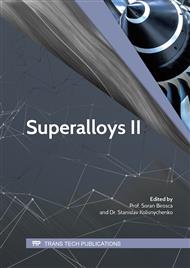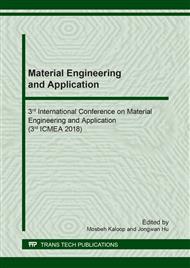[1]
H. Singh, R. Gary, Effects of process parameters on material removal rate in WEDM, J. Achieve. Mat. Manuf. Eng., 32 (2009) 70-74.
Google Scholar
[2]
V. Parashar, A. Rehman, J. L. Bhagoria, Y. M. Puri, Statistical and regression analysis of Material Removal Rate for wire cut Electro Discharge Machining of SS 304L design of experiments, Int. J. Eng. Sci. Technol., 2(5) (2010) 1021-1028.
DOI: 10.4028/www.scientific.net/amm.110-116.1683
Google Scholar
[3]
J. C. Rebelo, A. M. Dias, J. L. Lebrun, Influence of EDM pulse energy on the surface integrity of matensitic steels, J. Mat. Proc. Technol., 84 (1998) 90-96.
DOI: 10.1016/s0924-0136(98)00082-x
Google Scholar
[4]
B. H. Yan, F. Y. Huang, H. M. Chow, J. Y. Tsai, Micro-hole machining of carbide by electric discharge machining, J. Mat. Proc. Technol., (1999) 139-145.
DOI: 10.1016/s0924-0136(98)00345-8
Google Scholar
[5]
H. H. Lee, Taguchi Methods: Principles and Practices of Quality Design, Taipei: Gau Lih Book Co., LTD., (2011).
Google Scholar
[6]
Y. C. Lin, A Study on Electrical Discharge Machining and Multiple Quality Characteristics of W/Cu Composites, Master's thesis, Program of Weapon System Eng., Chung Cheng Inst. Technol., National Defense University, (2002).
Google Scholar
[7]
M. C. Huang, C. C. Tai, The Effective Factor in the Warpage problem of an Injection- Molded part with a Thin Shell Feature, J. Mat. Proc. Technol., 110(1) (2001) 1-9.
DOI: 10.1016/s0924-0136(00)00649-x
Google Scholar
[8]
M. T. Haganm, H. Demuth, M. H. Beale, Neural networks Design, Thomson Learning, (1996).
Google Scholar
[9]
W. T. Miller, R. S. Sutton, P. J. Werbos, Neural networks for control, MIT Press, (1990).
Google Scholar
[10]
D. A. White, D. A. Sofge Edited, Handbook of intelligent control, Neural, Fuzzy, and Adaptive Approaches, Van Nostrand Reinhold, (1992).
Google Scholar
[11]
W. S. Lin, B. Y. Lee, C. L. Wu, Modeling the surface Roughness and Cutting Force for Turning, J. Mat. Proc. Technol., 108(3) (2001) 286-293.
Google Scholar
[12]
J. Z. Wu, Application of Neuro-Fuzzy System and Genetic Algorithms in Multi-objective Machining-parameters Optimization, Master's thesis, Depart. Mech. Eng., National Taiwan Ocean University, (2000).
Google Scholar
[13]
C. B. Yang, C. G. Lin, H. L. Chiang, C. C. Chen, Single and multi-objective optimization of Inconel 718 nickel-based superalloy in the wire electrical discharge machining, Int. J. Adv. Manuf. Technol., 93 (2017) 3075-3084.
DOI: 10.1007/s00170-017-0758-3
Google Scholar
[14]
W. Y. Fowlkes, C. M. Creveling, Engineering Methods for Robust Product Design: using Taguchi Methods in Technology and Product Development, Addison Wesley Longman, Inc., California, (1995).
DOI: 10.1016/0737-6782(96)90138-1
Google Scholar



